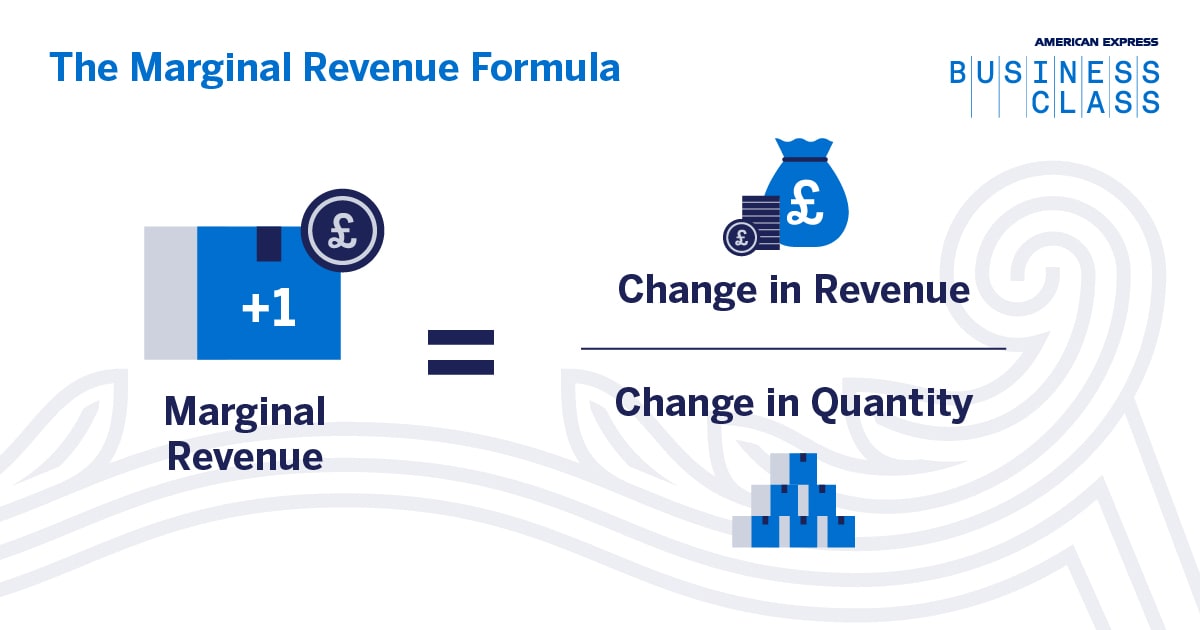Measuring marginal metrics helps businesses assess the effectiveness of small changes or incremental improvements on a product-by-product basis. Marginal revenue, one of these metrics, is important because it's often used to guide pricing, production levels, and resource allocation for profit growth.
"Understanding marginal revenue helps businesses set the right prices to maximise sales and profits," says Daniel Woolf, Head of Policy at Enterprise Nation. "By analysing how changing prices affect total revenue and marginal revenue, companies can find the sweet spot where raising prices slightly increases total revenue despite potentially selling less."
Let's look at how to calculate marginal revenue and use it to boost profits.
How to calculate marginal revenue
 |
Marginal revenue is the incremental change in earnings resulting from the sale of one extra unit of a product or service before the costs of producing or delivering that unit are accounted for. To calculate marginal revenue, divide the change in total revenue by the change in quantity sold, as follows:
Marginal Revenue = Change in Total Revenue / Change in Quantity Sold
Change in total revenue
This is the total revenue your company earns from selling an additional unit of its product or service. For example, say in January you sell 50 units and earn £100. In February, you sell 100 units and earn £200. The change in total revenue from January to February is £100.
Change in quantity sold
Change in quantity sold refers to the new quantity of products or services that you are selling, minus your previous quantity. Taking the example above, the change in quantity sold between January and February is 50 units.
Marginal revenue calculation example
Let's work through an example of how you can use the marginal revenue calculation in practice.
In the first quarter of the year, an artisan business makes 100 handbags and sells 50 of them for £100 each. Its total revenue from handbags for that quarter is £5,000.
In the second quarter, they make another 100 handbags, giving them a total of 150 including those unsold from the first period. However, they anticipate selling only 50 handbags based on previous sales, which would leave them with a new surplus of 100. The larger the product surplus, the larger the excess costs, such as the need for increased storage space.
To mitigate these concerns, the business decides to lower the price to £80 per bag. Consequently, they sell 80 bags in the second period, increasing sales by 30 from the previous period and raising total revenue to £6,400.
To calculate its marginal revenue, first, the business must find the change in total revenue:
Change in Total Revenue = New Total Revenue (£6,400) - Old Total Revenue (£5,000) = £1,400
Next, the business has to find the change in quantity sold:
Change in Quantity Sold = New Quantity Sold (80) - Old Quantity Sold (50) = 30
Using both the change in total revenue and the change in quantity sold, the artisan business is now able to calculate its marginal revenue:
Marginal Revenue = Change in Total Revenue (£1,400) / Change in Quantity Sold (30) = £46
The business has worked out that lowering its selling price can increase sales and generate a marginal revenue of £46 per unit. This raises overall business revenue in Q2 by £1,400. But - as Woolf notes - while lowering prices can result in more sales and an increase in total revenue, it can also mean making less extra revenue from each additional item sold.
To understand this further, we need to consider marginal revenue against marginal costs. That is, the costs incurred from making each additional handbag. Let's say that it costs your business £40 to make a handbag. Deducting £40 from the marginal revenue of £46 means your business is actually only making £6 per extra bag sold.
Now imagine it only costs £20 to make a handbag. Deducting this cost from the £46 marginal revenue means the business is now making £26 per sale.
Understanding marginal revenue
Marginal revenue and marginal cost
Marginal revenue is the amount you earn from selling an extra unit before any costs involved with creating that unit are deducted. These costs are known as marginal costs, and they typically include things like raw material sourcing, labour, packaging and delivery.
"If marginal revenue is higher than marginal cost, it means making and selling more units is profitable," says Woolf, which means a company may consider increasing production if demand and resources allow. Conversely, if marginal revenue is lower than marginal costs, making more units isn't profitable and a company may explore reducing production levels.
Marginal revenue and marginal profit
Marginal profit is the extra earnings from selling one more item after taking into account production costs. It helps identify how minor changes in expenses like raw material prices impact product profitability during business growth.
As sales and profits increase, you may need to invest to expand the production of your products or services. The extended 54-day payment terms of the American Express Business® Gold Card means you can invest in growth-generating activities upfront and pay later, giving you more time to make additional sales¹. What's more, for each full and eligible £1 spent, you'll earn one Membership Rewards® point, which you can spend on products or technology that support business scale².
Marginal revenue and economies of scale
Companies can enjoy economies of scale when the average cost of creating an additional unit of product or service decreases as a company produces more. This is because producing higher volumes can result in new efficiencies, such as bulk discounts from suppliers. These cost reductions can significantly affect marginal revenue.
Gareth Austin-Jones, Director of London-based footwear brand, Cocorose London, says that when designing a new collection, he works closely with his manufacturing partners to identify where cost savings could be made. Often these are tied to economies of scale, such as using the same fabric across multiple designs to lower unit costs, he adds.
"If there are no economies of scale, each additional unit made has a relatively high production cost," Woolf says. "Without cost efficiencies from scaling-up, the extra revenue from additional sales is constrained, hurting profits and growth."
How to use marginal revenue to maximise profits
Arguably, maximising profits is the aim of the game. One way this can be achieved is to gradually increase production until the revenue earned from selling each additional unit matches the cost of making or delivering it. This is known as the optimal level of production.
Beyond the optimal level of production, the amount earned from selling one more unit will be lower than what it costs your business to create that unit, leading to diminishing returns. "By closely tracking marginal revenue data, companies can identify the exact production level where marginal revenue starts dipping below marginal cost, which signals the maximum profitable output level," Woolf explains.
For footwear company Cocorose London, production and logistics costs are key factors influencing marginal revenue, which means identifying efficiencies in manufacturing and procurement.
You can also compare marginal revenue across products. A footwear company like Cocorose London, for example, may find trainers have a higher marginal revenue than ballet flats, and lower marginal costs. This could mean they can then focus on manufacturing more trainers while still meeting demand for ballet flats.
Additionally, you can experiment with marginal revenue in pricing strategies. For example, you could test a price change through an online promotion to see the 'real-world' impact on marginal revenue and then use this data to inform permanent pricing decisions, thereby reducing risks, explains Woolf.
"Understanding marginal revenue is about understanding your data and working smarter, not harder," says Woolf. "How a company prices its products matters for its marginal revenue."
1. The maximum payment period on purchases is 54 calendar days and is obtained only if you spend on the first day of the new statement period and repay the balance in full on the due date. If you'd prefer a Card with no annual fee, rewards or other features, an alternative option is available – the Business Basic Card.
2. Membership Rewards points are earned on every full eligible £1 spent and charged, per transaction. Terms and conditions apply.



